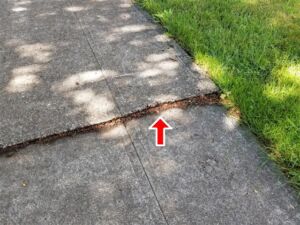
Sometimes people may be surprised when home inspectors point out trip hazards around the home. Some people may think that it’s obvious that the concrete has a ledge, so why report it? Home inspectors report trip hazards since they are a health and safety concern. Personal injury caused by a trip hazard on or around your property will not only ruin your day, but may also lead to an expensive lawsuit. In many jurisdictions homeowners are responsible for maintaining the sidewalk in front of their house. If they fail to do so, and someone trips and hurts themselves, homeowners can end up in court, and may have to pay a substantial settlement.
Trip hazards can be caused at concrete and asphalt surfaces by installation errors, soil below the concrete settling or expanding, or from tree roots. Most ledges at concrete slabs can be easily repaired by grinding down the concrete with a grinder and diamond blade grinder pad, or by adding more material to the concrete surface to create a smooth transition. In extreme cases, where large slabs have moved significantly, hiring a professional to level or replace the concrete may be the best course of action.
There are several methods to level concrete slabs, such as mud-jacking, or by injecting foam under the slabs. This type of work should only be done by professionals, but for smaller trip hazards, repairs can easily be done by a home owner. It is important to choose the right tools and materials when repairing trip hazards.
One option for repair is to grind down the concrete. When using a grinder to remove concrete and create a smooth transition, it is important to consider the amount of dust that can be created by grinding the concrete. This is why it is best to wet down the surface that you are grinding to prevent excess concrete dust. Concrete dust contains silica, which is a carcinogenic material. It is important to use a face mask or respirator when grinding concrete. Also, wearing eye, ear and hand protection is necessary to avoid personal injury during repairs.
When adding material to repair a trip hazard, it is important to choose the right materials, and to make sure that the existing surfaces are clean. Many materials that are available have a primer material that is installed on the existing surface prior to installing the filler material, in order to ensure a permanent and durable bond. Manufacturer’s installation instructions must be followed when working with concrete filler materials. Otherwise you risk more cracking and deterioration of the material.
Check out the videos below to find out more on how you can repair concrete trip hazards.
